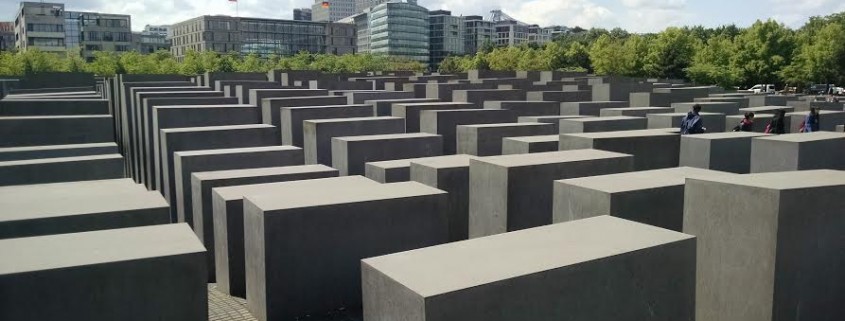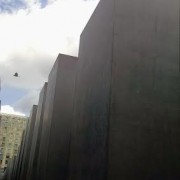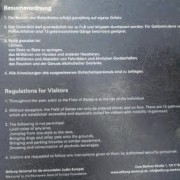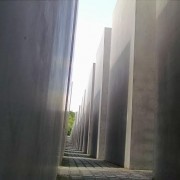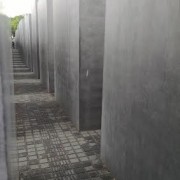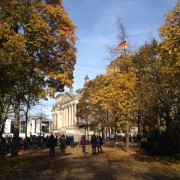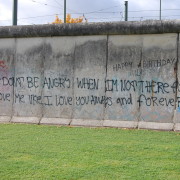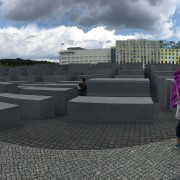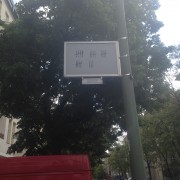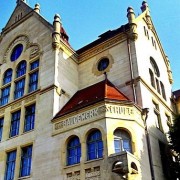Field of Stelae
By Kylie Britt
A memorial is a structure that creates a place of memory pertaining to a certain event or group of people. The city of Berlin is a place with a rich history and as the capital of Germany it is home to many national memorials commemorating the country’s past. In one afternoon my classmates and I visited four memorials representing different groups that suffered devastating losses during the Second World War and the Holocaust, but one memorial drew more controversy and confusion among the group than most, the Memorial to the Murdered Jews of Europe. Although I was primed to be disappointed after reading the article by Richard Brody titled, The Inadequacy of Berlin’s “Memorial to the Murdered Jews of Europe”, I was surprised by my appreciation of those aspects of this monument that others found to be its faults.
The Memorial to the Murdered Jews of Europe spans across more than four acres in the middle of the city near the Riechstag and the Brandenburg Gate surrounded by busy streets, tall buildings on three sides, and a park. This memorial consists of 2,711 concrete rectangular slabs approximately 2 feet in width and of varying heights resembling coffins. The height of each slab ranged from less than a foot to more than twelve feet. These massive structures are evenly spaced in rows. The concrete pillars gradually increase in height as one moves toward the center of the memorial.
The chief complaint of many who visit the memorial as well as the criticism made by Brody in his article is that the memorial is significantly lacking in signage or representation of the murdered Jews it represents. There is no plaque or inscription with the title of the memorial, there are no names of victims, number of deaths, no reference to the Holocaust or Second World War or even a symbol of Judaism. Only at the bottom of the safety plaques scattered around the ‘field of stelae’ does it vaguely reference the “Memorial to the Murdered Jews of Europe foundation”.
What I find most interesting about this memorial is how by not outright declaring it to be a memorial I believe more people are drawn to experience it. To an ignorant outsider this memorial could be mistaken as a modern art piece or a unique new public space, a concrete park of sorts. This memorial is not like any other I have ever visited for this very reason. While some people are attracted to memorials as a site of memory, which they visit to trigger their thought processes and reflections, many people will go out of their way to avoid feeling uncomfortable and will avoid a place of remembrance. This is what makes this unmarked memorial much more accessible. A person can stumble upon this massive exhibit and wander over the uneven ground and through the leaning pillars not knowing what they represent; and hopefully by the end of their exploration they have asked about the exhibit or discovered the Jewish Holocaust exhibit underneath the memorial itself. In this way the memorial is not something that ends the conversation about the past atrocities but starts a new one by sparking interest in someone who might have avoided a traditional site of remembrance.
The intent and prior knowledge of the visitor affects the way they experience the memorial. My visit to the memorial was much more solemn due to what I already knew of the memorial and why it was created. When wandering through the rows of growing concrete coffins one can feel overwhelmed. The ground slopes downward and as you weave through the pillars the ground slants left and right over little hills and some of the pillars lean out of line from one another. The area gets darker as you get closer to the heart of the memorial, it would be easy for one to feel lost and confused by the disorienting experience. In the small unfamiliar path one could feel scared and panicky. In some ways these emotions symbolize the feelings one has as they remember the death of six million people. These feelings may also symbolize the way a person in denial about or whom is trying to ignore the holocaust may have felt.
There are also other ways to experience the Memorial to the Murdered Jews of Europe. During my somber visit I saw many smiling people, kids giggling and running, young adults climbing on top of the pillars, and adults hiding and joking around pillars. I would definitely find these activities to be disrespectful and completely unacceptable at a monument, a sculpture, or a statue, but at an interactive unmarked memorial it is easier to accept. The innocent actions of the unaware can be considered a representation of the people who did not know about or ignored the mass killing of six million people.
In a way I think this naivety allows a site of remembering to become a site of memory making. The child running around a pillar will not understand today the gravity of what is represented there, but at age twelve, sixteen, or twenty, they will have a memory of being there and hopefully understand. The memory of what happened to six million Jews will not be tarnished by laughter on a warm day, the nervous smile as you bump into another member of your visiting group as you explore the pathways does not make this memorial any less prominent or important.
The tourist groups who come to visit the memorial can still deeply reflect on the effects of the Holocaust at the site. On the day of my visit there were many group discussions and tours spread out around the massive memorial, many of these groups were seated in discussion on the bench height pillars of the memorial. These reflective visitors can visit the information center to gain more understanding of the people being memorialized. I have been told that the information center beneath the memorial exhibits many details and facts about the Jews before and during the Holocaust, but unfortunately I was unable to visit the information center during my visit.
I have heard multiple arguments as to how this memorial to the Murdered Jews of Europe is inadequate, and for me this raised the following question: What is an adequate to representation of the slaughter of six million innocent people? Despite much thought I cannot come up with an answer. Then I thought of the definition of a memorial; a structure to remind people of a person or an event. This raised another question for me: How do you remind the people who do not want to be reminded? And then I remembered, the question posed to my classmates and myself a few days prior to our visit to Berlin. Does building a memorial create discussion or end the discussion or past events? While the answers to these questions can be quite circumstantial, I believe the Memorial to the Murdered Jews of Europe tackles them quite well. It is inviting to those already aware of its existence, and it is a simple Google search away from individuals interested in learning about Holocaust memorials who have never heard of it. While at the same time its anonymity allows people to discover it without being scared away by the negative and depressing connotations they may hold with words like the Holocaust, a memorial, World War II, the Jews. The physical memorial draws people in, sparks their interest, and allows them to be reminded of the murdered Jews of Europe. The section of the memorial that is located above ground may not be adequate in depicting the exact atrocities but, it does more than an adequate job of drawing the attention of masses, opening the door for the discussion of past events with those who would normally ignore them, and providing a place where individuals can learn more about the past.
All attached photos were taken by Kylie Britt.

